
|
End of Field Season
Full Report
by Mark Lehner
Acknowledgments
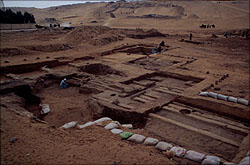 Our 1997 excavation season of the Koch-Ludwig Giza Plateau Mapping Project
drew to a close on March 29, 1997. For a very successful season, we are
grateful to Dr. Ali Hassan, President of the Supreme Council of Antiquities,
and Dr. Zahi Hawass, Director General of Giza and Saqqara, for their
cooperation in making our work possible. We thank Mr. Sabry Abd al-Aziz,
Director of Giza for his kind assistance. We are grateful to Mr. Mansour
Radwan, Senior Inspector, and to Mr. Ashraf Mahmoud, who represented the
Supreme Council of Antiquities at the excavation site.
We would like to thank Mr.
Hisham Nasser and Ms. Abir Sayed who served as our inspectors in the
storeroom. We would also like to thank the American Research Center in Egypt,
especially Amira Khattab and Amir Hassan.
Our 1997 excavation season of the Koch-Ludwig Giza Plateau Mapping Project
drew to a close on March 29, 1997. For a very successful season, we are
grateful to Dr. Ali Hassan, President of the Supreme Council of Antiquities,
and Dr. Zahi Hawass, Director General of Giza and Saqqara, for their
cooperation in making our work possible. We thank Mr. Sabry Abd al-Aziz,
Director of Giza for his kind assistance. We are grateful to Mr. Mansour
Radwan, Senior Inspector, and to Mr. Ashraf Mahmoud, who represented the
Supreme Council of Antiquities at the excavation site.
We would like to thank Mr.
Hisham Nasser and Ms. Abir Sayed who served as our inspectors in the
storeroom. We would also like to thank the American Research Center in Egypt,
especially Amira Khattab and Amir Hassan.
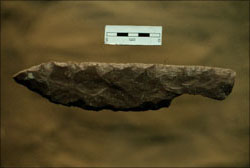 Our 1997 field season would not have been possible without the financial
support of David Koch, Bruce Ludwig, Ann Lurie, Robert Lowdermilk, Marjorie
Aronow, and Jon Jerde. We are grateful to Craig Smith and the Los Angeles office of Daniel,
Mann, Johnson, & Mendenhall for financial and equipment support. We once
again extend our deep appreciation to SOKKIA Corporation for the loan of a
total station. I would also like to thank Professor Lawrence Stager, The Harvard
Semitic Museum, and the Oriental Institute of the University of Chicago for sponsoring
this work.
Our 1997 field season would not have been possible without the financial
support of David Koch, Bruce Ludwig, Ann Lurie, Robert Lowdermilk, Marjorie
Aronow, and Jon Jerde. We are grateful to Craig Smith and the Los Angeles office of Daniel,
Mann, Johnson, & Mendenhall for financial and equipment support. We once
again extend our deep appreciation to SOKKIA Corporation for the loan of a
total station. I would also like to thank Professor Lawrence Stager, The Harvard
Semitic Museum, and the Oriental Institute of the University of Chicago for sponsoring
this work.
 The team consisted of Dr. Mark Lehner (Harvard Semitic Museum and the
University of Chicago), Director; Dr. Richard Redding (Michigan Museum of
Natural History), faunal analyst; Ms. Mary Anne Murray (Institute of
Archaeology, University College, London), archaeobotanist; Mr. John Nolan
(University of Chicago), archaeologist and Assistant Director; Mr. Carl
Andrews, data base manager and photographer; Ms. Justine Way (University of
Chicago), archaeologist; Mr. Jason Ur (University of Chicago), archaeologist;
and Mr. Thomas Kittredge (Yale University), archaeologist, and Mr. Mohsen
Kamel, archaeologist. Mr. Ramsi Lehner worked as square supervisor and
storeroom assistant. Other team members could only be with us in the field for
a short time, or helped with advance work at home. Our surveyors are Mr. David
Goodman and Ms. Katrina Olson. Dr. Peter Lacovara, Department of Ancient
Egyptian and Near Eastern Art at the Museum of Fine Arts, Boston, is our ceramicist.
Ms. Nina Catubig, Boston Science Museum, is our registrar.
The team consisted of Dr. Mark Lehner (Harvard Semitic Museum and the
University of Chicago), Director; Dr. Richard Redding (Michigan Museum of
Natural History), faunal analyst; Ms. Mary Anne Murray (Institute of
Archaeology, University College, London), archaeobotanist; Mr. John Nolan
(University of Chicago), archaeologist and Assistant Director; Mr. Carl
Andrews, data base manager and photographer; Ms. Justine Way (University of
Chicago), archaeologist; Mr. Jason Ur (University of Chicago), archaeologist;
and Mr. Thomas Kittredge (Yale University), archaeologist, and Mr. Mohsen
Kamel, archaeologist. Mr. Ramsi Lehner worked as square supervisor and
storeroom assistant. Other team members could only be with us in the field for
a short time, or helped with advance work at home. Our surveyors are Mr. David
Goodman and Ms. Katrina Olson. Dr. Peter Lacovara, Department of Ancient
Egyptian and Near Eastern Art at the Museum of Fine Arts, Boston, is our ceramicist.
Ms. Nina Catubig, Boston Science Museum, is our registrar.
Summary of the Previous 1991-95 Seasons
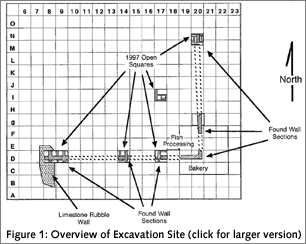 Our excavations are in the area in the low desert south of the large stone
wall in the place called Heit el-Ghurob. We refer to this general area,
between Kafr Gebel and the high desert, and extending about 450 meters south of
the large stone wall, as Area A. In our 1997 season we once again reopened the
excavation area that we call A7, south of the soccer field and west of A-B
Riding stables. In our 1991 season we found two intact bakeries in A7. The
baking was carried out in two rooms, defined by low stone walls that contained
bread molds, large vats, and hearth platforms.
Our excavations are in the area in the low desert south of the large stone
wall in the place called Heit el-Ghurob. We refer to this general area,
between Kafr Gebel and the high desert, and extending about 450 meters south of
the large stone wall, as Area A. In our 1997 season we once again reopened the
excavation area that we call A7, south of the soccer field and west of A-B
Riding stables. In our 1991 season we found two intact bakeries in A7. The
baking was carried out in two rooms, defined by low stone walls that contained
bread molds, large vats, and hearth platforms.
These two bakery rooms were attached to a large mudbrick building enclosed by
a wall 1.5 meters thick. Just prior to our Spring 1991 season, a back hoe had
made two large holes in this place, just missing the bakeries, but destroying
much of the southeast corner of the large mudbrick building. In 1995 we
excavated three 5 x 5 meter squares (E18, F19, G20 in fig. 1) to find out more
about this building and the kinds of activities that the Fourth Dynasty
Egyptians carried on inside the mudbrick wall. We found curious low benches
separated by narrow troughs or channels and paved with marl (tafla ) clay.
Embedded in the floor alongside these benches, we found very fragile remains of
fish bone. The evidence we found in 1991 and 1995 indicated we were excavating
a food-production center, perhaps the institution called per shena
('commissariat'?) in hieroglyphics texts and tomb scenes.
1997 Objectives
A review of ancient Egyptian food preparation at other sites and other periods
indicates that such production was attached to households - large houses of
prominent people, palaces, or temples, as "houses of the gods." Middle and New
Kingdom granaries, bakeries, breweries, carpenter and weaving shops were
attached in modular fashion to large households, as, for example, in the town
connected to the 12th dynasty pyramid of Senwosret II at Illahun, or within
urban estates at the 18th Dynasty site of Tell el-Amarna. Our bakeries and fish
processing area are inside, or attached to the exterior, of an open-air
enclosure, defined, at least in the southeast corner, by the large mudbrick
wall. Similarly, production facilities in large households and urban estates
known from other sites and periods are often located in an enclosure around the
core residence.
The prime objective in our excavations this season, therefore, was to try to
get a sense of the larger structure or complex to which these food production
facilities were attached, and, more simply, to see how far this very regular
building complex extended. This objective required laying out excavation
squares to the north and west, following the alignment of the large mudbrick
wall which turns a southeast corner where the bakeries attach to it. A second
objective, as in each field season, was to sort and analyze all classes of
material that we retrieved from previous seasons of excavations.
Work in the Storeroom
 The Giza Inspectorate assigned us a new storage area west of the mastaba
field, west of the Khufu Pyramid. Much of our time was spent working here in
the first two weeks of the field season, and most afternoons during the entire
field season. We unpacked our material and sorted it according to excavation
areas, features, and material (ceramic, bone, charcoal, mud sealings, lithics,
etc.). We sorted by using a grid work of palm reed crates stacked against the
walls of the storeroom. Due to the limited space in the new storeroom, much of
our work was conducted outside and on the roof of the low building.
The Giza Inspectorate assigned us a new storage area west of the mastaba
field, west of the Khufu Pyramid. Much of our time was spent working here in
the first two weeks of the field season, and most afternoons during the entire
field season. We unpacked our material and sorted it according to excavation
areas, features, and material (ceramic, bone, charcoal, mud sealings, lithics,
etc.). We sorted by using a grid work of palm reed crates stacked against the
walls of the storeroom. Due to the limited space in the new storeroom, much of
our work was conducted outside and on the roof of the low building.
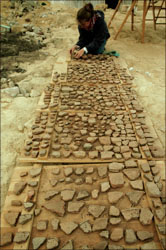 We spent much of the first two weeks sorting all the pottery from layer 16 in
our 1991 excavation square, A7, according to the typology that we worked out in
previous seasons. This typology is an adaptation of the typology of Old Kingdom
pottery prepared by George Reisner from his excavations of the great mastaba
cemeteries that flank the Great Pyramid of Khufu, and from a small town of
priests and servants attached to the Menkaure Valley Temple through dynasties
Five and Six, after the period of pyramid building at Giza. Our pottery, from a
Fourth dynasty settlement area, will make an important comparison with the
pottery from these and other Old Kingdom funerary and temple contexts. A7/16
was one of our largest collections of material, and it was probably discarded
or dumped from the bakeries and fish-processing areas. It should reveal much
about the activities and products that the Fourth dynasty Egyptians were using.
As expected, the greatest quantity of the pottery was bread molds, a subject of
ongoing analysis in our project.
We spent much of the first two weeks sorting all the pottery from layer 16 in
our 1991 excavation square, A7, according to the typology that we worked out in
previous seasons. This typology is an adaptation of the typology of Old Kingdom
pottery prepared by George Reisner from his excavations of the great mastaba
cemeteries that flank the Great Pyramid of Khufu, and from a small town of
priests and servants attached to the Menkaure Valley Temple through dynasties
Five and Six, after the period of pyramid building at Giza. Our pottery, from a
Fourth dynasty settlement area, will make an important comparison with the
pottery from these and other Old Kingdom funerary and temple contexts. A7/16
was one of our largest collections of material, and it was probably discarded
or dumped from the bakeries and fish-processing areas. It should reveal much
about the activities and products that the Fourth dynasty Egyptians were using.
As expected, the greatest quantity of the pottery was bread molds, a subject of
ongoing analysis in our project.
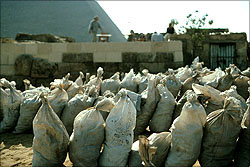 As with almost all archaeological projects in Egypt, we now sorely need a
study season—in which we do nothing but sort and analyze material and
refrain from further digging until we catch up. Much of the story our site has
to offer is revealed in the analysis of this material. Richard Redding's work
is an example. During his weeks with the project he analyzed much of the bone
from previous seasons. The following are only his preliminary impressions,
before he prepares a more detailed report based on his meticulous studies.
As with almost all archaeological projects in Egypt, we now sorely need a
study season—in which we do nothing but sort and analyze material and
refrain from further digging until we catch up. Much of the story our site has
to offer is revealed in the analysis of this material. Richard Redding's work
is an example. During his weeks with the project he analyzed much of the bone
from previous seasons. The following are only his preliminary impressions,
before he prepares a more detailed report based on his meticulous studies.
Loaves and Fishes Revisited
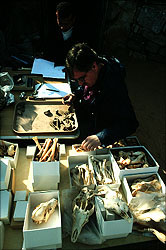 Of the fish remains, the Nile catfish (Clarias) and schal (Synodontis) are
the most common. Richard found that those tiny bits of bone that we recovered
from the floor of the 'benches and troughs' area included some from mammal as
well as fish. Also, we found fish bone from a number of different places in our
excavations, not only alongside the benches. So we cannot be certain that the
benches and troughs were exclusively for cleaning fish—although the term
"fish processing area" has almost been as ingrained in our site vocabulary as
the term "bakeries," which we know to exist.
Of the fish remains, the Nile catfish (Clarias) and schal (Synodontis) are
the most common. Richard found that those tiny bits of bone that we recovered
from the floor of the 'benches and troughs' area included some from mammal as
well as fish. Also, we found fish bone from a number of different places in our
excavations, not only alongside the benches. So we cannot be certain that the
benches and troughs were exclusively for cleaning fish—although the term
"fish processing area" has almost been as ingrained in our site vocabulary as
the term "bakeries," which we know to exist.
As for mammals, Richard's analysis shows a significant number of young male
cattle, under two years of age, probably brought to Giza on hoof and
slaughtered for meat nearby (remember, no refrigerated delivery trucks in
ancient Egypt!). Cattle in general are considered a costly source of meat. They
are fussier about their food and need to drink more than sheep and goats which
have wider grazing habits. Cattle are certainly more costly than pigs, which
are omnivorous and reproduce quickly. Pigs, which cannot move long distances,
are associated more with a provincial village way of life.
 Our paleobotanists, Wilma Wetterstrom (Harvard Botanical Museum) and Mary Anne
Murray (Institute of Archaeology, University College, London), report, as their
preliminary impression, that the plant remains show little evidence, such as
chaff and parts of field weeds, of the initial stages in the complex processing
of cereals from field to mouth. This may indicate that cereal grain is coming
into the site already cleaned.
Our paleobotanists, Wilma Wetterstrom (Harvard Botanical Museum) and Mary Anne
Murray (Institute of Archaeology, University College, London), report, as their
preliminary impression, that the plant remains show little evidence, such as
chaff and parts of field weeds, of the initial stages in the complex processing
of cereals from field to mouth. This may indicate that cereal grain is coming
into the site already cleaned.
So, to be simplistic, we are seeing evidence of expensive grain and expensive
meat. If these impressions hold up to closer scrutiny, this material reflects a
higher status of consumers than in village sites in provincial Egypt. That is,
we may be digging the discarded remains - the garbage - of an expensive way of
life, the economy of what some archaeologists would call the Egyptian elite.
These patterns perhaps bode well for the 'palace hypothesis' - the idea that we
are excavating the back part of an outer enclosure around a royal residence of
the pyramid building kings.
On the other hand, although our ratio of cattle bone to sheep, goat, and pig
might be comparatively high, we have fish in abundance. Fish were a cheap,
common, source of meat protein in ancient Egypt. Catfish could easily be
harvested from catchment basins when the annual flood waters—that turned the
Nile valley floor into a shallow lake for six to eight weeks every year—receded. Also, stacked against evidence of expensive meat and grain is another
major impression that we take from our site, amply reinforced by our work this
season, namely, the enormous quantities of the discarded material.
You may have read elsewhere on this Web site of the huge numbers of bread mold
sherds from our processing of A7/16 (see 'Mysteries of the Bread Pot'). Again
this season we often had to dig through enormous dumps of pottery, bone, and
other ancient trash to delineate the architecture in its various phases. We
found such a dump covering the main wall of our interest in square D17 (see
below). Just about everywhere on the site, often mixed with the stone and
mudbrick debris that may have been purposefully used to level this building
complex after it was abandoned, we find quantities of dumped material that must
indicate a high volume of consumption. Could just the royal family and
retainers have consumed so much bread and other stuff in a generation or two?
Or are we thinking in the wrong terms to expect, in this early period, an
"elite" completely separated from a "workforce"? What clues would we find in
the architecture?
Excavations
Each season we back-fill, or rebury, the archaeological structures of our
excavation, in order to protect them from dumping, from horse, camel, and
people traffic, and from the natural processes of decay that affect such
fragile remains of mudbrick, tafla (desert clay), broken stone and mortar.
Because of our back-filling, we have been able to remove the fill each season
since 1989 and find our site in good condition.
(continue: Organization of Excavation Squares)
Photos: Carl Andrews and Mark Lehner
Pyramids Home | Pyramids | Excavation
Contents | Mail
|